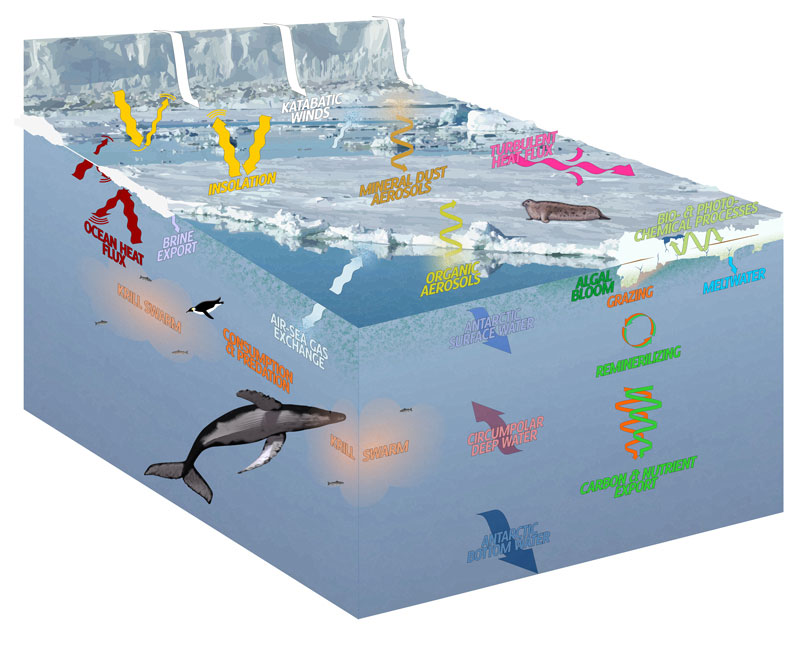- Home
- Publications
- PAGES Magazine
- Cycles of Sea-Ice Dynamics In The Earth System Working Group
Cycles of Sea-Ice Dynamics in the Earth System working group
Leventer A, Kohfeld KE, Allen CS, Crosta X, Marzocchi A, Prebble J & Rhodes RH
Past Global Changes Magazine
27(2)
71
2019
Amy Leventer1, K.E. Kohfeld2, C.S. Allen3, X. Crosta4, A. Marzocchi5, J. Prebble6 and R.H. Rhodes7
Sea ice is a critical component of the climate system (Fig. 1), influencing heat and gas exchange between the atmosphere and polar oceans. Given the high albedo of sea ice relative to that of open water, seasonal variability in sea-ice extent impacts reflectivity of the Earth's surface. Changes in the Antarctic sea-ice seasonal cycle also affect Southern Ocean water mass buoyancy, thereby modulating Southern Ocean upper and lower overturning cells and global ocean circulation. Through its interactions with the glacial ice margin, sea ice affects, and is affected by, ice sheets and ice shelves. Finally, sea-ice decay impacts ocean primary productivity through its roles in seeding phytoplankton and driving upper-ocean stratification and nutrient distribution (e.g. Armand et al. 2017). At present, average Antarctic sea-ice extent ranges between summer minima of ~3 million km2 to winter maxima of ~18 million km2 (Cavalieri and Parkinson 2008). Changes in sea-ice extent over longer time periods have been studied since the late 1970s. Community-based research efforts have focused on understanding different sea-ice proxies (e.g. the PAGES Sea Ice Proxies working group), and on reconstructing Antarctic sea-ice extent for specific time periods, such as the Last Glacial Maximum through the project MARGO (Multiproxy Approach for the Reconstruction of the Glacial Ocean Surface; Gersonde et al. 2005).
 |
|
Figure 1: Principal feedbacks and interactions between Antarctic sea ice and the ocean, biosphere, atmosphere, and cryosphere (reproduced from Patterson et al. 2019). |
The C-SIDE working group (pastglobalchanges.org/c-side) was established to extend Southern Ocean sea-ice reconstructions back further in time, with a focus on the past 130,000 years. This longer timescale allows us to evaluate the role of sea ice on major climate transitions including the glacial inception, when carbon was sequestered in the ocean, and deglaciation, when ocean carbon reserves were released into the atmosphere. This time frame also encompasses the penultimate interglacial when Antarctica was ~2ºC warmer than today – a useful "process" analogue for future warming scenarios. The main difference between C-SIDE and previous large-scale projects (MARGO) is that C-SIDE aims to document sea-ice dynamics along with understanding processes and interactions between Antarctic sea ice and global climate on different timescales. In addition, C-SIDE aims to include these data in Earth system modeling efforts, including the Paleoclimate Modelling Intercomparison Project (pmip3.lsce.ipsl.fr).
Our first C-SIDE workshop was held from 24-26 October 2018 in Vancouver, Canada (Patterson et al. 2019; doi.org/10.22498/pages.27.1.31). Major accomplishments included developing a format for compiling proxy datasets from both marine-sediment and ice-core records, establishing an initial inventory of 170 sites with potential information on sea-ice changes, and assigning data-mining efforts to be completed before the next workshop. These tasks are critical as we seek to provide denser spatial coverage and higher temporal resolution of sea-ice variability through time.
Our second workshop, "Sea-ice database and model-data framework" (https://doi.org/10.22498/pages.27.2.86), was held 29-31 August 2019 in Sydney, Australia, immediately prior to the 13th International Conference on Paleoceanography (pastglobalchanges.org/calendar/128542). The primary goal was to complete our inventory of paleo records, with details about the temporal extent of each published, unpublished, and future targeted record, as well as the data type used to reconstruct sea ice. These include, but are not limited to, diatom assemblages, organic biomarkers such as highly branched isoprenoids, isotopic evidence, and geochemical data from ice cores. Our database will be completed by entering sea-ice records that allow for examination of full time series as well as spatial patterns associated with specific time intervals, including the Holocene, the last 40 kyr, MIS 5, and the last 130 kyr. Ultimately, our plan is to target regional transects, extending from ice sheets to the equatorward extent of sea ice. We recognize that, at this time, only a limited number of datasets extend back 130,000 years, with even fewer that span latitudinal transects. However, identification of the data gaps is critical for the establishment of new priorities for future field-based data collection.
Affiliations
1Department of Geology, Colgate University, Hamilton, NY, USA
2School of Resource and Environmental Management, Simon Fraser University, Burnaby, BC, Canada
3British Antarctic Survey, Cambridge, UK
4University of Bordeaux, France
5National Oceanography Centre, Southampton, UK
6GNS Science, Lower Hutt, New Zealand
7Department of Geography and Environmental Sciences, Northumbria University, Newcastle-upon-Tyne, UK
contact
Karen Kohfeld: kohfeld sfu.ca
sfu.ca
references
Cavalieri DJ, Parkinson CL (2008) J Geophys Res Oceans 113: C07004
